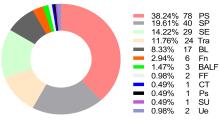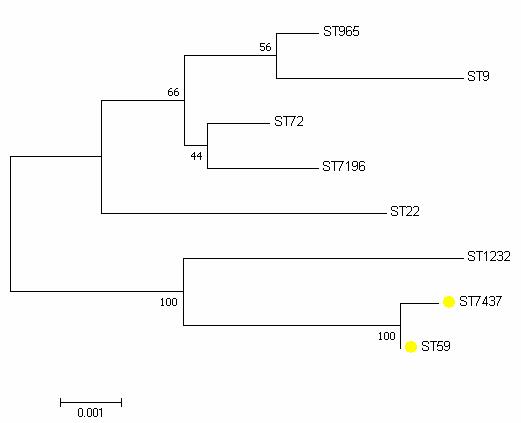| 1 |
HARMSEN D, CLAUS H, WITTE W, et al. Typing of methicillin-resistant Staphylococcus aureus in a university hospital setting by using novel software for spa repeat determination and database management[J]. J Clin Microbiol, 2003, 41(12): 5442-5448.
|
| 2 |
WANG W Y, LEE S Y, CHIUEH T S, et al. Molecular and phenotypic characteristics of methicillin-resistant and vancomycin-intermediate staphylococcus aureus isolates from patients with septic arthritis[J]. J Clin Microbiol, 2009, 47(11): 3617-3623.
|
| 3 |
ENRIGHT M C, DAY N P, DAVIES C E, et al. Multilocus sequence typing for characterization of methicillin-resistant and methicillin-susceptible clones of Staphylococcus aureus [J].J Clin Microbiol,2000,38(3): 1008-1015.
|
| 4 |
MCCLURE-WARNIER J A, CONLY J M, ZHANG K Y. Multiplex PCR assay for typing of staphylococcal cassette chromosome mec types Ⅰ to Ⅴ in methicillin-resistant Staphylococcus aureus [J].J Vis Exp,2013(79): 50779.
|
| 5 |
BOSWIHI S S, UDO E E, MONECKE S, et al. Emerging variants of methicillin-resistant Staphylococcus aureus genotypes in Kuwait hospitals[J]. PLoS One, 2018, 13(4): e0195933.
|
| 6 |
ZHOU W X, JIN Y, LIU X, et al. Comparison of genetic features and evolution of global and Chinese strains of community-associated methicillin-resistant staphylococcus aureus ST22[J]. Microbiol Spectr, 2022, 10(1): e0203721.
|
| 7 |
KLEIN S, HANNESEN J, ZANGER P, et al. Entry of panton-valentine leukocidin-positive methicillin-resistant Staphylococcus aureus into the hospital: prevalence and population structure in Heidelberg, Germany 2015—2018[J]. Sci Rep, 2020,10(1): 13243.
|
| 8 |
WANG X Y, ZHAO H L, Wang B J, et al. Identification of methicillin-resistant Staphylococcus aureus ST8 isolates in China with potential high virulence[J]. Emerg Microbes Infect, 2022, 11(1): 507-518.
|
| 9 |
GARGIS A S, YOO B B, LONSWAY D R, et al. Difficult-to-detect staphylococcus aureus: mecA-positive isolates associated with oxacillin and cefoxitin false-susceptible results[J]. J Clin Microbiol, 2020, 58(4): e02038-e02019.
|
| 10 |
LIANG B S, XIONG Z L, LIANG Z W, et al. Genomic basis of occurrence of cryptic resistance among oxacillin-and cefoxitin-susceptible mecA-positive Staphylococcus aureus [J].Microbiol Spectr,2022,10(3): e0029122.
|
| 11 |
GOERING R V, SWARTZENDRUBER E A, OBRADOVICH A E, et al. Emergence of oxacillin resistance in stealth methicillin-resistant Staphylococcus aureus due to mecA sequence instability[J]. Antimicrob Agents Chemother, 2019, 63(8): e00558-e00519.
|
| 12 |
JIAN Y, LI T M, ZHAO L, et al. Regulation of bla system in ST59-related oxacillin-susceptible mecA-positive Staphylococcus aureus [J]. J Antimicrob Chemother, 2022, 77(3): 604-614.
|
| 13 |
BA X L, HARRISON E M, EDWARDS G F, et al. Novel mutations in penicillin-binding protein genes in clinical Staphylococcus aureus isolates that are methicillin resistant on susceptibility testing, but lack the mec gene[J].J Antimicrob Chemother,2014,69(3): 594-597.
|
| 14 |
BA X L, KALMAR L, HADJIRIN N F, et al. Truncation of GdpP mediates β-lactam resistance in clinical isolates of Staphylococcus aureus [J].J Antimicrob Chemother, 2019, 74(5): 1182-1191.
|
| 15 |
LI S G, SUN S J, YANG C T, et al. The changing pattern of population structure of Staphylococcus aureus from bacteremia in China from 2013 to 2016: ST239-030-MRSA replaced by ST59-t437[J]. Front Microbiol, 2018, 9:332.
|
| 16 |
WANG B J, XU Y L, ZHAO H L, et al. Methicillin-resistant Staphylococcus aureus in China: a multicentre longitudinal study and whole-genome sequencing[J]. Emerg Microbes Infect, 2022, 11(1): 532-542.
|
| 17 |
YAMAGUCHI T, NAKAMURA I, SATO T, et al. Changes in the genotypic characteristics of community-acquired methicillin-resistant Staphylococcus aureus collected in 244 medical facilities in Japan between 2010 and 2018: a nationwide surveillance[J]. Microbiol Spectr,2022, 10(4):e0227221.
|
| 18 |
OGURA K, KAJI D, SASAKI M, et al. Predominance of ST8 and CC1/spa-t1784 methicillin-resistant Staphylococcus aureus isolates in Japan and their genomic characteristics[J]. J Glob Antimicrob Resist, 2022, 28: 195-202.
|
| 19 |
HOLDEN M T, HSU L Y, KURT K, et al. A genomic portrait of the emergence, evolution, and global spread of a methicillin-resistant Staphylococcus aureus pandemic[J]. Genome Res, 2013, 23(4): 653-664.
|
| 20 |
RICCOBONO E, GIANI T, BALDI G, et al. Update on activity of dalbavancin and comparators against clinical isolates of Gram-positive pathogens from Europe and Russia (2017—2018), and on clonal distribution of MRSA[J]. Int J Antimicrob Agents, 2022, 59(2): 106503.
|
| 21 |
XIONG M Y, ZHAO J, HUANG T, et al. Molecular characteristics, virulence gene and wall teichoic acid glycosyltransferase profiles of Staphylococcus aureus: a multicenter study in China[J]. Front Microbiol, 2020, 11: 2013.
|
| 22 |
DIEP B A, CARLETON H A, CHANG R F, et al. Roles of 34 virulence genes in the evolution of hospital- and community-associated strains of methicillin-resistant Staphylococcus aureus [J]. J Infect Dis, 2006, 193(11): 1495-1503.
|
| 23 |
WARD M J, GONCHEVA M, RICHARDSON E,et al.Identification of source and sink populations for the emergence and global spread of the East-Asia clone of community-associated MRSA[J]. Genome Biol, 2016, 17(1): 160.
|
| 24 |
MLYNARCZYK-BONIKOWSKA B, KOWALEWSKI C, KROLAK-ULINSKA A,et al.Molecular mechanisms of drug resistance in Staphylococcus aureus [J]. Int J Mol Sci, 2022, 23(15): 8088.
|
| 25 |
WANG X, LIU Q, ZHANG H, et al. Molecular characteristics of community-associated Staphylococcus aureus isolates from pediatric patients with bloodstream infections between 2012 and 2017 in Shanghai, China[J]. Front Microbiol, 2018, 9: 1211.
|
| 26 |
ZHAO R, WANG X, WANG X H, et al. Molecular characterization and virulence gene profiling of methicillin-resistant Staphylococcus aureus associated with bloodstream infections in Southern China[J]. Front Microbiol, 2022, 13: 1008052.
|
| 27 |
SUNG J Y, LEE J, CHOI E H, et al. Changes in molecular epidemiology of community-associated and health care-associated methicillin-resistant Staphylococcus aureus in Korean children[J]. Diagn Microbiol Infect Dis, 2012, 74(1): 28-33.
|
| 28 |
TAVARES D A, SA-LEAO R, MIRAGAIA M,et al. Large screening of CA-MRSA among Staphylococcus aureus colonizing healthy young children living in two areas (urban and rural) of Portugal[J]. BMC Infect Dis, 2010, 10: 110.
|
| 29 |
PARK K H, CHONG Y P, KIM S H, et al. Community-associated MRSA strain ST72-SCCmecⅣ causing bloodstream infections: clinical outcomes and bacterial virulence factors[J]. J Antimicrob Chemother, 2015, 70(4): 1185-1192.
|
 )
)
 )
)






